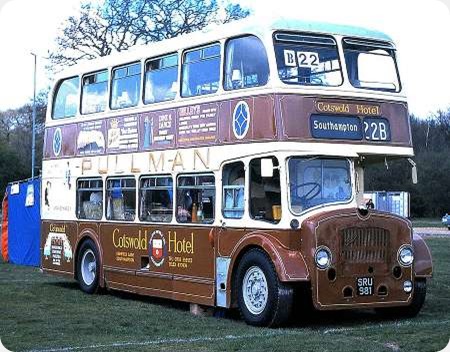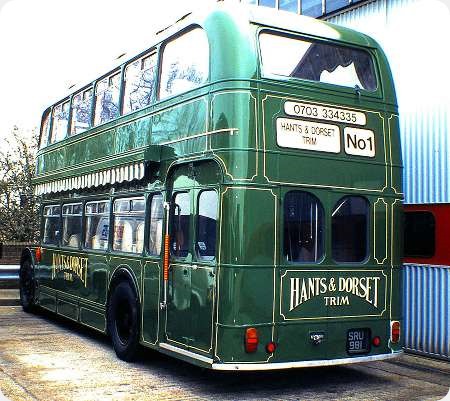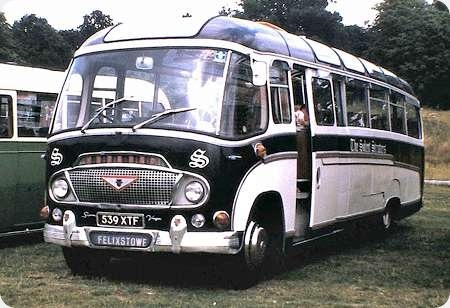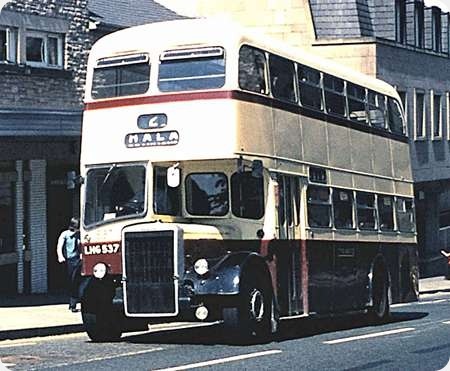
Hants & Dorset Motor Services
1956
Bristol Lodekka LD6
ECW H33/27R
SRU 981 was new to Hants & Dorset in 1956 as their 1368. It is a Bristol LD6 with ECW body H60R seating when new. The Bristol engine was replaced by a Gardner in 1961, making it a Bristol LD6G and doors were fitted in that year. In the first view, on Southampton Common on 6 May 1979, it has been sold to the Cotswold Hotel as a mobile dining facility. The occasion is the Southampton City Transport Centenary rally.

In this second view, taken on 2 April 1995, it is in the Southampton Citybus yard in Portswood, in the livery of Hants & Dorset Trim. It was with the ‘new’ Crosville, in Weston Super Mare when the 2012 PSVC list was compiled.
Photograph and Copy contributed by Pete Davies
11/08/16 – 06:30
Would I be right in thinking that SRU981 would have been one of the first Lodekkas with the squarer front grille as opposed to the deeper front panel on earlier models? Also I notice in the lower picture that Lucas combination tail lights have been fitted. Originally I think that model had a stop/tail bulb on the inside of the body behind the reflectors. This meant that the stop lights were virtually impossible to see in sunny weather, and after a short while when the bulbs & inside of the reflectors got dusty, making them impossible to see in just about any conditions. I think originally indicators were fitted on the sides at the front only (like Southampton Corporation for a while) but later round Lucas indicators were fitted above the reflectors. Saved a lot of money in rear corner panel repairs by doing that!
David Field
Quick links to the - Comments Page - Contact Page - Home Page

Solent Strutters Majorettes
1962
Bedford SB5
Duple C41F
539 XTF was a Bedford SB5 with Duple C41F body, and it has been relegated to duty for the Solent Strutters Majorettes group. The registration indicates it was new to an operator in Lancashire in the period 1961 to 1963, depending on the gap between order and delivery (Look, for example, at Lancaster’s 201-203 YTE). We see it in the rally at Netley on 13 July 1986: soon after this it sank to even greater depths with travellers and has since been scrapped. So much is fact, but now we have a question: who was its first operator?
Photograph and Copy contributed by Pete Davies
17/07/16 – 08:12
New to Barnes, Rawtenstall, Lancashire in March 1962, along with with 540 XTF.
David Hick
18/07/16 – 08:39
Thank you, David. I did wonder if the first operator might have been Battersby/Silver Grey of Morecambe. They had several of this combination (well, SB if not this model).
Pete Davies
29/09/19 – 07:08
539 and 540 XTF were the only Barnes fleet members taken into the Ellen Smith of Rochdale fleet when Smiths took over Barnes business. I think they were retained because they possessed a Leyland engine (Smiths were big Leyland users). Ellen Smith kept them until 1967 and they were replaced by two new Bedford VAM/Plaxton coaches.
Andrew Spriggs
30/09/19 – 06:26
Going back to 539 to 540 XTF, many years ago whilst on hire to Ellen Smith one of their drivers told me each one had a Leyland engine. However the original caption of 539 XTF says its a SB5 which would indicate Bedfords own engine. A Leyland power unit would indicate them being SB8 or SB13 models. Perhaps some engine swapping has gone on?, we will never know as most of Ellen Smiths drivers I remember from forty years ago who would know have retired from coach driving or sadly passed away.
Andrew Spriggs
06/10/19 – 08:06
Ended its days with travellers https://www.travellerhomes.co.uk/?p=2356
John Wakefield
Quick links to the - Comments Page - Contact Page - Home Page

Lancaster City Transport
1961
Leyland Titan PD3/6
East Lancs H41/32F
At Local Government Reorganisation in 1974, Lancaster merged with Morecambe & Heysham to form a ‘new’ Lancaster City Transport. The operator found itself short of modern, serviceable, vehicles and some were acquired from Maidstone Borough, some from what had become Burnley & Pendle, one from Merthyr Tydfil, and there was even a Seddon (ex Demonstrator) which has appeared on these pages already. LHG 537 is one of the Burnley contingent, a Titan PD3/6 with East Lancs H73F body, dating from 1961. In this view, she is climbing the hill of Great John Street, towards Lancaster Town Hall, on the 2 to Hala. It is 20 May 1975 and she is still in the Burnley arrangement of maroon and cream – not a great deal different from the Lancaster arrangement – with fleetname in Tilling style.
Photograph and Copy contributed by Pete Davies
16/07/16 – 05:30
Lancaster also bought a lowbridge Atlantean from Trent and a number of ex Salford ones from GMTPTE In addition an ex Wallace Arnold Leyland Leopard was bought from Fishwick.
Chris Hough
16/07/16 – 17:16
Pete is quite correct when he says that the enlarged Lancaster undertaking was short of modern vehicles, much of the fleet comprising ageing AEC Regents at Morecambe. What is quite amusing though is that the "modern" fleet additions he mentions comprised of a variety of buses built between 1957 and 1961, so on arriving around 1974 were somewhat long in the tooth themselves!
The one depicted – and its sisters – were never used as OPO buses in Lancaster and nor were they in Burnley. However, the window to the left and behind the driver appears to have been modified, presumably for the purpose of OPO – and I note the unusual position of the mirror underneath the second ‘A’ of the destination, presumably to give the driver a view of the lower saloon/platform area with a view to being used single-manned.
Dave Towers
18/07/16 – 06:56
This batch of PD3’s had the front bulkhead window arrangement from new. It was a common arrangement on early forward entrance double deckers to allow drivers to see the platform and communicate with the conductor but OPO of double deckers was at that time a long way off becoming legal. The arrangement was tidied up on later designs with the whole front window being angled to avoid the two-piece window. After this it became less noticeable.
Philip Halstead
Quick links to the - Comments Page - Contact Page - Home Page




